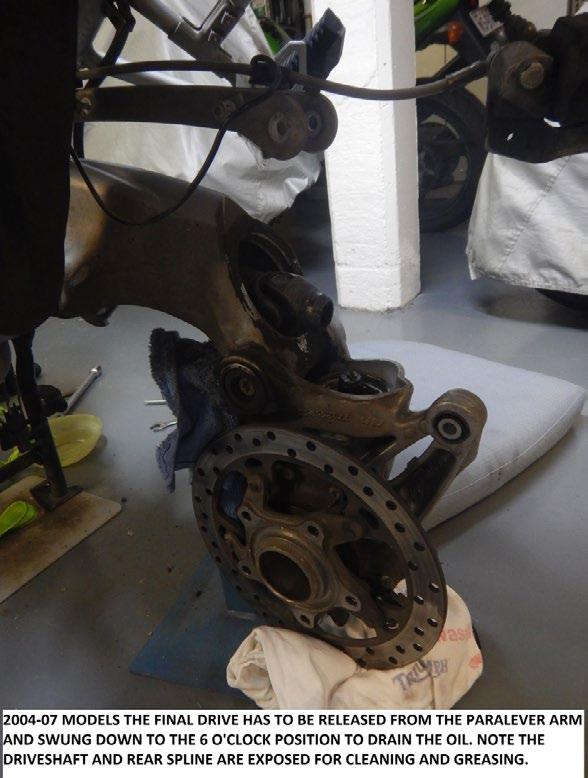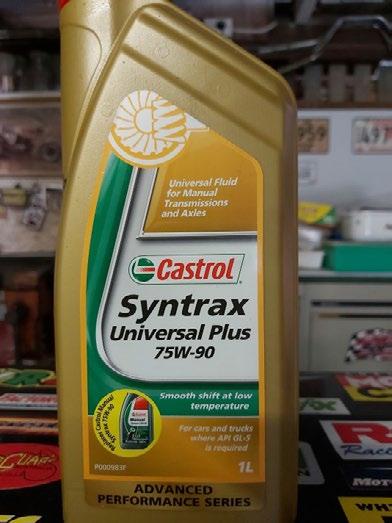
4 minute read
MAiNTENANCE CoRNER
By Tony Gray, Member #3905
There can be no more misunderstood component of a ‘modern’ BMW boxer than the Final Drive. A lot of the blame IMHO can be sheeted home to BMW. When BMW replaced the 1100/1150 oil-head range of BMW boxer engined bikes in 2004 with the 1200 hex-head range, it completely redesigned the bike. I tend to remember BMW stating that no component transferred across the range. The shaft drive and final drive was of a completely different design and as the old saying goes ‘then the fight started’. Google BMW R1200 Final Drive Issues and you could be forgiven for thinking that all BMW Final Drives are destined to fail – it’s just a matter of time! When released in 2004 the final drive unit on the R1200 range did not have an oil drain plug or a filler plug on the final drive unit. There was no maintenance schedule to change the oil on the FD unit or to grease the splines on the shaft drive. The oil capacity of the FD was listed as 220cc. The conclusion to be drawn was that the FD unit was
‘sealed for the life of the bike’ unless major repair work was to be undertaken. My own experience with the ‘Grey Ghost’, my 2007 R1200GS, was one of sublime ignorance in regard to the FD until one day returning from Kingaroy on a club ride I started getting a terrible rumbling from the rear end – no, it wasn’t from a spicy vindaloo. A slow ride into Goomeri and inspection showed oil all over the rear of the bike and a clearly collapsed main bearing in the final drive. We returned home in a tilt tray truck courtesy of RACQ. That was in 2017 when the Ghost had 141,000km on the dial. I stripped down the FD which showed the main caged roller bearing collapsed and the main seal torn allowing the oil to escape. Otherwise the casing, crown & pinion gears etc. were all in excellent condition. I priced a full suite of bearings and seals from BMW, decided I was too old to take out a second mortgage on the house, and obtained a second hand unit from a 2009 model with 39,000km to its credit.

To my surprise the replacement FD unit had a plug to drain the oil but the only way to put oil into the FD unit was still via the rear wheel speed sensor as per the earlier models. This was fiddly, but no great problem. On my earlier model there was no drain plug at the bottom of the unit in the 6 o’clock position but a plug at the rear of the FD at the 3 o’clock position. To use that as a ‘drain plug’ requires the removal of the rear wheel, brake caliper, Paralever arm and speed sensor. The FD unit then can be disconnected from the drive shaft and ‘hinged’ on the pivot bolt so that the rear plug comes down to the 6 o’clock position to drain the oil. My research also revealed that BMW had reduced the oil capacity recommendation from 220cc to 180cc. There is a lot of suspicion that the greater oil volume may build up too much pressure in the FD unit and ‘blow’ the seal. That may have been the cause of my problem? That was not the end of the changes to the FD unit as BMW added a filler hole to later models (I think from 2010 but I could be wrong there) meaning the speed sensor need not be disturbed when changing the oil. It is extremely awkward to remove the speed sensor with the rear wheel in place so I always remove the rear wheel as part of the FD service. This is not necessary with the models fitted with a filler plug. Finally on the later wetheads the filler plug was relocated to a convenient location on the rear of the FD unit where it should have been in the first place.
My replacement unit has now done approx. 120,000km ‘combined’ mileage without problem. I change the FD oil every 20,000km using only Castrol Syntrax 75W-90 transmission oil, carefully measured to 180cc. If you have a later model from 2008 on then changing the oil is a simple task. The 2004-2007 models require extra work but this is a straightforward exercise for a reasonably competent home mechanic. The only ‘advantage’ with the earlier models is that the oil draining process requires you to split the shaft from the final drive so an ideal time for a clean and regrease of the rear splines. That will be covered in a future article.

Give yourself peace of mind and add this to your regular maintenance schedule.











